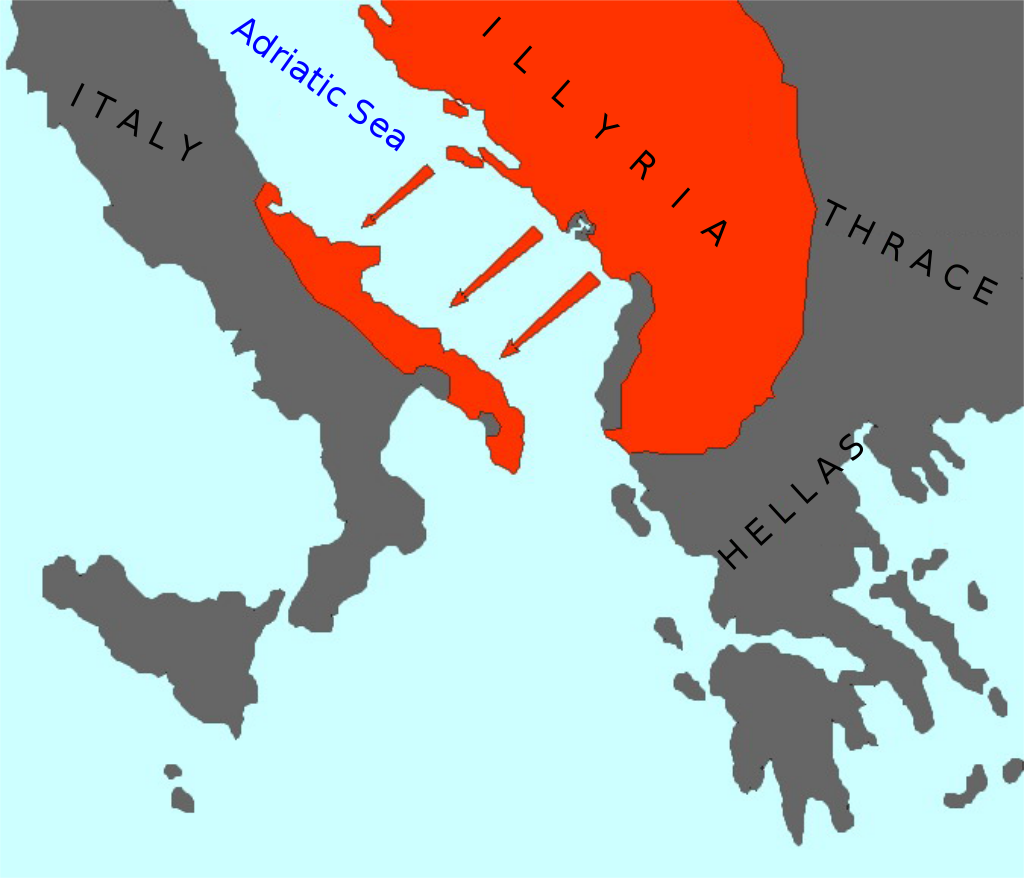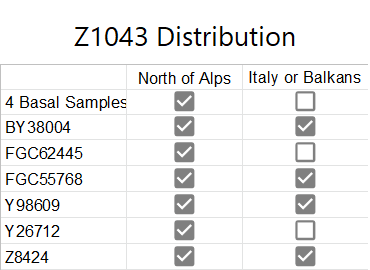A man buried in the Via Salaria Necropolis, north of Rome, has been found to be J-Z631, according to the study Ancient Rome: A genetic crossroads of Europe and the Mediterranean published today in Science.
Sample R116 was estimated by direct radio carbon dating to have been buried between 0-200 CE. However given that this necropolis was closed by Trajan around 110 CE, this man was probably born in the first century.
The raw data has not yet been released. When it is, we may be able to determine a more specific subclade below Z631. This man's mother had mitochondrial haplogroup U3a2, which according to Eupedia "found in Yemen, Italy, Switzerland and Britain / found in the Kura-Araxes culture (Copper Age Armenia)".
From the abstract: "During the Imperial period, Rome’s population received net immigration from the Near East, followed by an increase in genetic contributions from Europe. These ancestry shifts mirrored the geopolitical affiliations of Rome and were accompanied by marked interindividual diversity, reflecting gene flow from across the Mediterranean, Europe, and North Africa."
Because of the political and economic importance of Rome, many people moved to the city from different parts of the empire. The study concluded his cultural affiliation was "Imperial Roman" so until any autosomal DNA or other information is analyzed which would imply a non-Italian origin, we should assume this man was indigenous. Knowing the percentage of residents of the city of Rome that came from Celtic regions would be useful, though I'm sure it was much less than half, which is why I'm assuming this man was an indigenous Roman.
According to the YFull estimates, this Roman sample was born about 800 years after the Z631 most recent common ancestor. While male lineages are capable of migrating hundreds or thousands of years in this time, it should be noted that Z631's next closest relative is a Z8421(xZ631) so far found in only one man who is from Roccascalegna in the province of Chieti, Italy. This is a 227 kilometer walk away from Rome and the common ancestor of these men lived 1600 BC.
Previously I had favored a Celtic theory for the child lineage Z1043 over the prevailing Balkanites-recruited-as-Roman-soldiers theory due to:
- Formation date closer to period of Celtic rather than Roman dominance
- Lack of Italian and Balkan diversity, with only two Italians and at the time no Balkanites on the YFull tree
- Geographic center of subclades in southern Germany
- Large number of successive prolific subclades seems more indicative of enduring dynastic power rather than a migration of middle class soldiers
- British, Spanish, Balkan and East European presence can all be explained by Celtic migrations of the 4th century
Balkanites in Z631 and Z1043
The Celtic theory became complicated by the discovery last year of two Albanians from Vlorë who occupy different subclades of Z631 which formed 800 BC, Y155546 and Y144394. These two subclades are hard to understand because they are also widely distributed - the former found in a "northwest European" and the latter in a Silesian.
Then came a surprising discovery that a man from Greece was positive for just two SNPs (FGC55758 * FGC55768) in the long, mostly German Z1043>PH1553 bottleneck. So the common ancestor of a modern Greek and Germans, FGC55768, lived 600 BC.
We also have a man whose ancestors came from Serbia in Z1043>BY38004, though his surname is German.
Recently Z1043>Y98609 has been found in a Bosniak.
Z631 Now More Certainly Balkan or perhaps Italian - What about Z1043?
There is now ancient Z631 only in Italy, upstream Z8421 only in Italy and two subclades of Z631 found in Albania. This makes a Balkan or Italian origin of Z8421 and Z631 seem most likely. Perhaps an Albanian origin of Z8421 is more likely than two independent migrations from Italy to the exact location of Vlorë in child lineage Z631. If Z8421(xZ631) is ever found in the Balkans, this would strengthen the argument.

While Balkan diversity of Z1043 has grown recently, the preponderance of basal Z1043 samples and subclades are north of the Alps.
This preponderance north of the Alps could be caused by sampling bias. Higher population levels due to early industrialization and current wealth and interest to test are found north of the Alps versus in the Balkans. Given this bias, the fact that Italians and/or Balkanites have been found in four of six identified Z1043 subclades might be indicative of an Italian/Balkan origin of Z1043.
It is exciting that we are finally making progress into determining the origin of Z631 by finding ancient DNA. After we learn the terminal subclade we will have more information to work with. We may decide to target Italian / Balkan men for J-M12 SNP panel testing which may reveal Italian / Balkan presence in the remaining J-Z1043 lineages.


I have no idea about deep origins but R116 is French-like so he might have been a non-local from a Celtic-speaking area between Iberia and Britain, drawn to Italy.
My nephew had his Ydna tested and he is J-z631
We cannot find much information on it. We have the line back to Huguenots that came to the US from France in 1600’s
I am J-Z631 and I am Polish American. My Grandfather was from the Galician region of Poland.
My brother tested as J-Z63, our great grandparents were German Russians from the Volga River area.
Always looking for more info.
Hi,
I’m J2(Z631). Mexican with spanish (proved) and scottish (allegedly. I have not proven it) roots.
All of my parents, grandparents, Great-grandparentsand Greatx2 grandparents were born in Mexico).
My Fathers was J2 subclade J-Z631 and traced his Elliott surname from Merseyside back to 1600s Warwickshire UK so far.
Hi Elliott,
This is my lineage as well, so I’m pretty knowledgeable of the surnames. You are the first Elliott I’ve seen to have this haplogroup. I recommend testing Alpha + Beta STRs if you are interested in the possibility of finding your closest male line relatives.
http://www.yseq.net/product_info.php?products_id=34
If you order it, join group 711 on YSEQ and I can tell you who your closest relatives are (if any have tested) and try to predict your specific lineage of J-Z631 (there are many).
Best
Hunter
I am jz631 and Born in Greece
Hi Gus,
There are several lines of J-Z631>Z1043 found in Greece. I just sent you an email to follow up.
best
Hunter
I am Italian and I am J-Z631 , my father was from Portico di Romagna(Forlì) a small town very close to Tuscany ,where I found my surname back to 1500’s.
Hello. I am also J-z631. My DNA didn’t show Italy or Balkan. It revealed British, German, French in low percentiles, however, i am of African descent. Primarily West Africa with Northeast African Ethiopian, Yemen which is where J haplo seems to be prevalent among Afro-Semitic populations.
Thanks for reaching out, I’ve replied to you via email.
Bonjour,
je suis français et J-Z631. Je fais actuellement des recherches pour en savoir plus sur mes origines. Si vous avez des informations supplémentaires or celles qui figurent sur vos articles, je serais enchanté d’en apprendre davantage. Aussi, au besoin, je peux essayer de vous aider d’une quelconque manière pour vos recherches.
En vous remerciant pour votre travail.
The haplotype j-z 631 is common In what today is Northern Greece and South Albania*. The ancient Epirus empire of king Pyro might have spread it to Italy and from there back North Europe. Some of the Epirus cities were with the side of Romans against the Macedonians during the Roman invention to Greece (explains the story).
*The movement to Southern Greece might occurred during the Ottoman years. The movement to Britain probably during the Roman years since they used recruits from the area.
Of course, it might be an independent migration to everywhere. And many Epirotes moved after the Ottoman invasion.
Hi Thomas,
Yes, Epirus-mediated migration is possible but we have also been found in ancient samples dating to earlier in the Iron Age in Italy so some J-L283 must have preceded any Epirus-mediated migration to Italy. Cetina culture is looking like a really good fit, especially given that in the recent Southern Arc study, a number of Cetina culture samples from the western Balkans were found positive for J2b-L283.
Check out my new J2b-L283 page where I have some relevant links to this study and the Cetina culture. I will continue to add new content.
https://phylogeographer.com/j2b-l283/
best
Hunter
Hi there, my parental haplogroup is J-Z631 and maternal haplogroup is H14 (tested with 23andMe), my parents both are from Bulgaria. Is there any other website to upload my raw DNA report to find more recent lineage of my J-Z631?
Thank you in advance.
Best regards
Hi Valeri,
What part of Bulgaria do you trace your father’s male line to?
You would need to do a more comprehensive test of your Y-DNA in order to learn your more recent lineage of J-Z631.
I recommend the J2b-M12 Panel at YSEQ. You will learn your exact lineage below J-Z631.
http://www.yseq.net/product_info.php?products_id=45234
However to advance the research the most, i.e. to learn if your sample creates a new branch with someone else, that would require doing a WGS test:
http://www.yseq.net/product_info.php?products_id=42468
This test followed by YFull analysis which would add your sample to the YFull tree and add any new branching points to our public research tree marking your sample as Bulgaria with whatever regional code you trace your father’s line to.
This is the current state of research of J-Z631 – https://www.yfull.com/tree/J-Z631/
best,
Hunter
Hi J-Z631family my name is George Votaw known as “Vauteau”, our surname is known in the Burgundy France region 11 century. It has been recorded at the society of Eduenns tranced to the Aedui tribe that was located at Bibracte in the Burgundy France.
Vauteau de Teutates.
Hi George,
It would be interesting to learn which exact lineage of J2b-Z631 your male line belongs to. This line ultimately traces back to the Western Balkans during the Iron and/or Bronze Age.
The J2b-M12 SNP Panel is a Y-DNA testing product offered by the YSEQ laboratory in Berlin that would determine your exact line of J2b-Z631.
https://www.yseq.net/product_info.php?products_id=45234
Best Regards,
Hunter
Hi There, I have discovered my haplogroup is J-Z631.
With the latest update in Ancestry myself is now showing 2% Northern Italy and my brother is showing 1% Sardinia
After reading the report in this website.. I am wondering what are the odds of this percentage showing up is matching up?
FTDNA is stating there is 211 J-Z631 branches and my Thompson linage being one of them?
My earliest Thompson is in Slingsby, Yorkshire around 1672.
Hope to hear your thoughts on this.
Regards
Tony Thompson
Hi Tony,
Thanks for your interest in our shared male line ancestry, as I’m also J2b-Z631. Your male line could have originated in Italy or the Western Balkans, but many living descendants have no trace of either in their autosomal DNA because the migration was so long ago. So having some Italian autosomal DNA isn’t proof on its own that your J2b-Z631 came from Italy vs Western Balkans.
I just checked and didn’t find any Thompsons in the public project on YSEQ or FTDNA so I can’t help you with your surname.
It’ll be necessary for you to do a Y-DNA test to determine which men are your closest male line relatives.
As an introductory test, I recommend the J2b-M12 SNP Panel at YSEQ because our line is so prolific that there may be noise in your STR matches (if only doing 37 STRs).
http://www.yseq.net/product_info.php?products_id=45234
Best,
Hunter
I’m Albanian from North Macedonia and my father’s Halpogroup is J-Z631.
Hello. My Haplogroup is J-Z631. I am Gagauz (Turkic). On the paternal side, ancestors are from Bulgaria (Kardzhali and Varna). Autosomal distances with ancient samples in the Vahaduo calculator:
Distance to: Panchev_simulated_g25_scaled
0.02164178 Bulgaria_Medieval
0.02606639 Italy_Medieval_01.SG
0.02685470 Hungary_MidAvar
0.02827243 Hungary_North HungaryMountains_LAvar
0.02864585 France_Sarrebourg_Late Antiquity_oLevant.SG 0.03313007 Serbia_LBA
0.03553428 Hungary_IA_Scythian_oAegean.SG
0.03581674 Italy_Tuscany_Grosseto_Etruscan_oLevant
0.03614792 Hungary_Transtisza_Roman_Sarmation
0.03659177 Austria_Klosterneuburg_Roman_oLevant.SG 0.03672355 Germany_EarlyMedieval_01.SG
0.03676368 Slovenia_Emona_Roman.SG
0.03726268 Germany_EMedieval_Alemanic_SEurope
0.03844683 Greece_Logkas_MBA.SG
0.03879716 Croatia_MLBA_alt
0.03935514 Moldova_Glinoe_Scythian.SG
0.03945009 Albania_Modern
0.03952395 Slovakia_Mikusovce_LaTene_Roman.SG
0.03957113 Hungary_EarlyMidAvar
0.03965895 Hungary_Langobard_o2
0.03993412 Slovakia_LIA
0.04024763 Croatia_Sipar_Roman.SG
0.04049021 Hungary_Langobard_01.SG
0.04144961 Italy_North_Early Medieval_Langobards_2
0.04176567 Macedonia_Medieval
Hi Anatoliy! Thanks for reaching out. I’m sending you an email. We have an active community on FB as well – https://www.facebook.com/groups/J.L283
Hunter
Thank you. I sent an application for admission, but they haven’t accepted me yet.